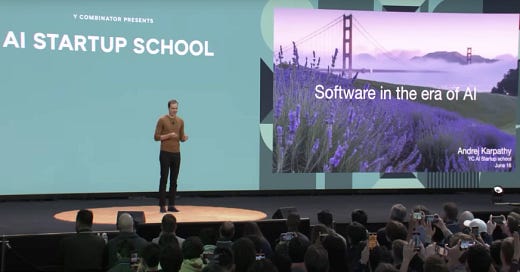The New Software Engineers: Adapting to an AI-Driven Development World
Andrej Karpathy reveals Software 3.0: how natural language programming is democratizing software creation and transforming the role of engineers worldwide.
Andrej Karpathy, OpenAI co-founder and former Tesla AI director, recently delivered a keynote at Y Combinator's AI Startup School in San Francisco on how AI is changing software, and his message was both revolutionary and remarkably practical.
Standing before an audience of entrepreneurs and technologists, the former OpenAI co-founder and Tesla AI director painted a picture of an industry on the cusp of its third major transformation.
Software is shifting from writing lines of code to interacting with machines through natural language. This isn't just another incremental improvement in development tools—it's a fundamental reimagining of what it means to create software, who can create it, and how engineers will navigate this brave new world.
For those who've watched the software industry evolve over decades, Karpathy's thesis feels both inevitable and startling. We've moved from punch cards to high-level programming languages, from procedural to object-oriented paradigms, and now we stand at the threshold of something unprecedented: programming computers in English.
The implications ripple far beyond Silicon Valley, touching every industry where software plays a role—which, in 2025, means virtually everywhere.
In this issue of Brewed for Work, we will explore Andrej Karpathy's groundbreaking keynote on Software 3.0, where natural language becomes the new programming interface. We'll examine how this shift from traditional coding to conversational AI is democratizing software creation, transforming engineering roles, and opening opportunities for professionals across industries. Discover why understanding this evolution isn't just relevant for developers—it's essential for anyone whose work intersects with technology in today's rapidly changing landscape.
So grab your favorite mug, and let's get brewing!
Today’s Issue at a Glance:
LLMs as the New Computing Infrastructure
The Curious Psychology of AI Systems
The Human-AI Collaboration Loop
The Democratization of Software Creation
Reimagining the Role of Software Engineers
Welcome to Brewed for Work, 🔒subscribers-only🔒 offering by The Percolator dedicated to professional growth and upskilling. Each week we share essays, insights and resources to aid you in your work-life.
🚀
Now, you can Upgrade your Subscription for Free when you Invite your Friends to Subscribe to The Percolator
The Three Ages of Software
To understand where we're heading, Karpathy argues we must first understand where we've been. Software has undergone two major transformations in recent history, and we're now witnessing the third. Each represents not just a technological shift, but a complete rethinking of how humans and computers collaborate.
» Software 1.0 represents the traditional paradigm most of us recognize as "programming." Developers write explicit instructions in programming languages like Python, Java, or C++ to make a computer perform specific tasks. This approach demands precision, extensive technical knowledge, and the ability to think in terms of algorithms and data structures. A developer wanting to perform sentiment analysis would need to craft explicit rules, handle edge cases, and debug complex logic chains.
» Software 2.0 emerged with the rise of machine learning and neural networks. Instead of hand-coding rules, developers train models by feeding them data. The "code" becomes the model's weights, refined through optimization rather than explicit instructions. Here, instead of writing sentiment analysis rules, a developer would curate training data and let neural networks learn patterns through backpropagation and gradient descent.
» Now, Software 3.0: The current frontier, where LLMs serve as programmable systems that interpret natural language prompts. You simply tell the machine, "Analyze the sentiment of this text: 'I love AI!'" And just like that, the machine understands, analyzes, and gives you the result. No explicit algorithms, no training data curation—just clear communication in natural language.
This progression reveals something profound about the democratization of technology. Each paradigm has lowered barriers to entry while expanding possibilities. The barrier to software creation is lowered dramatically, making programming more inclusive and accessible.
We're witnessing the emergence of what some call "vibe coding"—where individuals use natural language to conjure software solutions.
Keep reading with a 7-day free trial
Subscribe to The Percolator to keep reading this post and get 7 days of free access to the full post archives.





